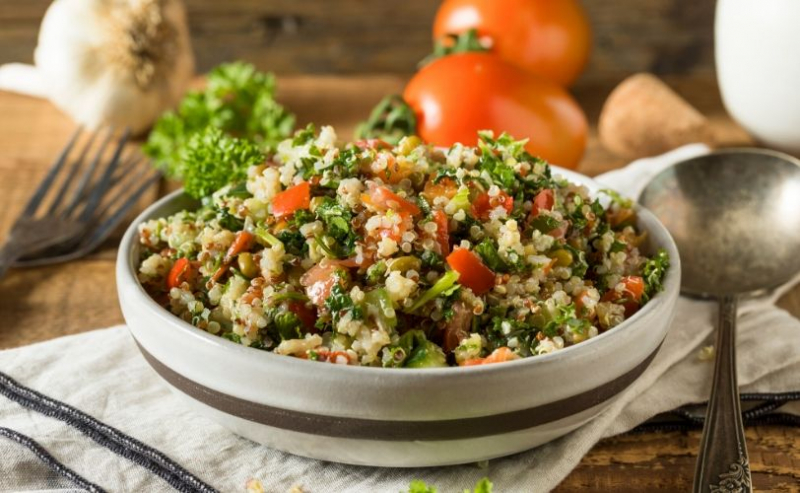5 easy ways to a healthy and varied diet
Eating a healthy and varied diet is a message you’ll often hear from nutritionists. Have you ever wondered why variety in the diet is beneficial and just how much variety you should aim to have in your diet?

The (lack of) diversity in our current diet
Of the 250,000 – 300,000 known edible plant species, only 150 to 200 are consumed by humans, and the average western diet utilises only a tiny fraction of these. In fact, today around 75% of the world’s food comes from only 12 plants and five animal species!
According to the United Nations, three-quarters of plant diversity has been lost since the 1900s (FAO, 2004). This has resulted in our modern diets often comprising of a limited range of plant-based foods.
The benefits of a varied diet
Having a wide variety of foods in your diet can help ensure that you get all the nutrients your body needs to function and feel well. It can also help stimulate your taste buds and make mealtimes more interesting!
Including a diverse range of plant-based foods, in particular, will provide your gut microbes with a diverse nutrient supply of dietary fibres, prebiotics and polyphenols. Better overall health is associated with greater diversity of gut bacteria. Dietary diversity even appears to increase longevity and the number of years lived in good health! (Miyamoto et al, 2019).
30+ different plant foods in a week
One of the largest published studies to date which has looked at how diet and lifestyle affect the human gut microbiome is the American Gut project (The American Gut Project, 2018).
Researchers of this study found that people who regularly ate 30+ different types of plant foods per week had a more diverse microbiome than those who ate 10 or fewer types of plants per week. Whether the individual was a meat-eater, vegetarian or vegan, it was the number of different plant foods in a person’s diet that had the greatest influence on the diversity of the gut bacteria.
Easy ways to increase variety in your diet
Including lots of plant food in your diet is great, but aiming to eat a wide variety of plant foods is even better. Now if 30+ different plant foods sound like quite a challenge, focus on adding different types of fruits, vegetables, legumes, whole grains, nuts, seeds and even different herbs and spices. Some examples are listed below for inspiration.
Fruits
- Apples, pears, bananas and plums.
- Figs, apricots and dates.
- Cherries, raspberries, limes and grapes.
- Nectarines, rhubarb and watermelon.
- Pineapple, strawberries and mango.
Vegetables
- Green beans, kale, cabbage and aubergine.
- Onions, peppers and radish.
- Broccoli, carrots, cabbage and lettuce.
- Courgette, onions, spinach and tomatoes.
- Leeks, mushroom, peppers and squash.
- Asparagus, beetroot, celeriac and watercress.

Legumes
- Black-eyed peas, baked beans, butter beans and cannellini beans,
- Chickpeas (and hummus), fava beans and green peas.
- Kidney beans, lentils (red, yellow, green and brown), mung beans and pinto beans.
Wholegrains
- Buckwheat, bulgar wheat and corn (popcorn or polenta).
- Freekah, millet, oats, and quinoa.
- Wholegrain rice, rye and wholewheat (pasta, bread and crackers.)
Nuts and seeds
- Almonds, Brazil nuts, cashews and chia seeds.
- Flax seeds, hazelnuts, hemp seeds and macadamia nuts.
- Pecans, pistachios, pumpkin seeds and sesame seeds (and tahini or sesame seed butter).
- Sunflower seeds, nut butter, and walnuts.
Herbs and spices
- Allspice, basil, chives, and coriander.
- Cinnamon, chilli powder, cumin and dill.
- Fennel, garlic, ginger, mint and mustard.
- Nutmeg, oregano, paprika and sage.
- Rosemary, thyme, turmeric.
Five tips for increasing your diet diversity
- It can be useful to have a look at the fruit and veg that are in season as these often taste their best and are more readily available, and sometimes cheaper than out-of-season produce.
- Variety can be found not just in fresh produce, but also in frozen, canned and dried produce.
- Buying pre-mixed combinations of salads, vegetables and beans can boost the variety. For example a vegetable stir-fry mix, a bag of frozen mixed vegetables or a can of mixed beans that you can add to a salad or stew.
- A pack of mixed seeds is useful to have in the kitchen as these can be sprinkled on top of a salad, on soup or a dessert.
- Experiment with different herbs and spices. Try adding a few shakes of dried herbs like parsley, oregano, thyme, basil, rosemary, chilli or cumin to meals. Spices such as cinnamon, ginger, allspice, and mint generally go well with desserts and fruits.
References:
- FAO (Food and Agriculture Organisation) (2004) What is happening to agrobiodiversity? Available: http://www.fao.org/3/y5609e/y5609e02.htm
- Miyamoto K, Kawase F, Imai T, Sezaki A, Shimokata H. Dietary diversity and healthy life expectancy—an international comparative study. Eur J Clin Nutr 2019; 73: 395–400.
- The American Gut Project (2018) Big Data from World’s Largest Citizen Science Microbiome Project Serves Food for Thought. Available: https://health.ucsd.edu/news/releases/Pages/2018-05-15-big-data-from-worlds-largest-citizen-science-microbiome-project-serves-food-for-thought.aspx

Find a nutritionist dealing with Healthy eating
All nutrition professionals are verified






